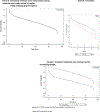Buprenorphine treatment receipt characteristics and retention among people who inject drugs at Integrated Care Centers in India
- PMID: 37031487
- PMCID: PMC10416117
- DOI: 10.1016/j.drugalcdep.2023.109839
Buprenorphine treatment receipt characteristics and retention among people who inject drugs at Integrated Care Centers in India
Abstract
Background: India is facing overlapping opioid injection and HIV epidemics among people who inject drugs (PWID) in several cities. Integrated Care Centers (ICCs) provide single-venue HIV and substance use services to PWID. We evaluated PWID engagement in daily observed buprenorphine treatment at 7 ICCs to inform interventions.
Methods: We analyzed 1-year follow-up data for PWID initiating buprenorphine between 1 January - 31 December 2018, evaluating receipt frequency, treatment interruptions (no buprenorphine receipt for 60 consecutive days with subsequent re-engagement), and drop-out (no buprenorphine receipt for 60 consecutive days without re-engagement). Using descriptive statistics, we explored differences between ICCs in the opioid-endemic Northeast region and ICCs in the emerging opioid epidemic North/Central region. We used a multivariable logistic regression model to determine predictors of treatment drop-out by 6 months.
Results: 1312 PWID initiated buprenorphine (76% North/Central ICCs vs. 24% Northeast ICCs). 31% of PWID in North/Central, and 25% in Northeast ICCs experienced ≥ 1 treatment interruption in 1 year. Over 6 months, 48% of PWID in North/Central vs. 60% in Northeast ICCs received buprenorphine ≤ 2 times/week (p < 0.0001). A third of PWID in North/Central vs. half in Northeast ICCs experienced treatment drop-out by 6 months (p < 0.001). In the multivariable model, living in Northeast cities was associated with increased odds of drop-out while counseling receipt was associated with decreased odds.
Conclusions: Retention among PWID initiating buprenorphine at ICCs was comparable to global reports. However, regional heterogeneity in retention, and low daily buprenorphine receipt suggest patient-centered interventions adapted to regional contexts are urgently needed.
Keywords: Buprenorphine; India; Opioid use; People who inject drugs; Retention; Treatment.
Copyright © 2023 The Authors. Published by Elsevier B.V. All rights reserved.
Conflict of interest statement
Conflicts of interest The authors have no conflicts of interest to declare.
Figures



Similar articles
-
Utilization of buprenorphine and methadone among opioid users who inject drugs.Subst Abus. 2018 Jan 2;39(1):83-88. doi: 10.1080/08897077.2017.1363844. Epub 2017 Sep 18. Subst Abus. 2018. PMID: 28796591 Free PMC article.
-
Respondent-driven sampling is more efficient than facility-based strategies at identifying undiagnosed people who inject drugs living with HIV in India.Drug Alcohol Depend. 2023 Aug 1;249:110834. doi: 10.1016/j.drugalcdep.2023.110834. Epub 2023 Jun 16. Drug Alcohol Depend. 2023. PMID: 37352733 Free PMC article.
-
Primary healthcare-based integrated care with opioid agonist treatment: First experience from Ukraine.Drug Alcohol Depend. 2017 Apr 1;173:132-138. doi: 10.1016/j.drugalcdep.2016.12.025. Epub 2017 Feb 21. Drug Alcohol Depend. 2017. PMID: 28242537 Free PMC article.
-
HIV among people who inject drugs in India: a systematic review.BMC Public Health. 2022 Aug 10;22(1):1529. doi: 10.1186/s12889-022-13922-2. BMC Public Health. 2022. PMID: 35948967 Free PMC article.
-
Integrated models of care for people who inject drugs and live with hepatitis C virus: A systematic review.Int J Drug Policy. 2019 Oct;72:146-159. doi: 10.1016/j.drugpo.2019.05.023. Epub 2019 May 27. Int J Drug Policy. 2019. PMID: 31147142
Cited by
-
Trajectories of medication for opioid use disorder and their impact on HIV testing among people who inject drugs in India: A longitudinal assessment of clinic-based data.Addiction. 2025 Apr;120(4):745-755. doi: 10.1111/add.16713. Epub 2024 Nov 27. Addiction. 2025. PMID: 39604070 Free PMC article.
-
HIV, hepatitis B & C in people who inject drugs in India: A systematic review of regional heterogeneity & overview of opioid substitution treatment.Indian J Med Res. 2023 Nov 1;158(5&6):522-534. doi: 10.4103/ijmr.ijmr_1930_23. Epub 2024 Jan 24. Indian J Med Res. 2023. PMID: 38265946 Free PMC article.
-
Expanding single-venue services to better engage young people who inject drugs: insights from India.Harm Reduct J. 2024 Sep 14;21(1):170. doi: 10.1186/s12954-024-01084-w. Harm Reduct J. 2024. PMID: 39272091 Free PMC article. Review.
References
-
- Ambekar A, Agrawal A, Rao R, Mishra AK, Khandelwal SK, and Chadda RK (2019). “Magnitude of Substance Use in India.” Ministry of Social Justice and Empowerment, Government of India https://pib.gov.in/newsite/PrintRelease.aspx?relid=188688&fbclid=IwAR1Rx....
-
- Ambekar A, Rao R, Agrawal A, and Mishra A (2018). “Punjab Opioid Dependence Survey: A Brief Report.” Ministry of Social Justice and Empowerment, Government of India
Publication types
MeSH terms
Substances
Grants and funding
LinkOut - more resources
Full Text Sources
Medical

